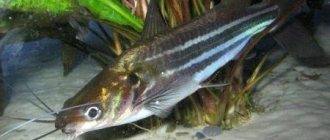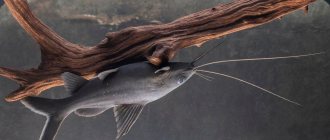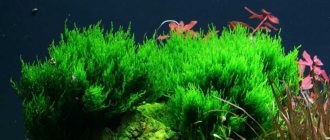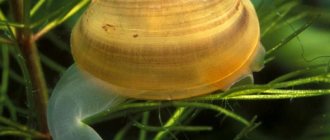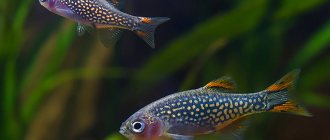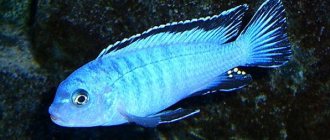Description
Cardamine or Heartwood is a genus in the Cruciferous family, which includes annual and perennial plants.
Some species are grown as ornamental garden specimens, but the most commonly cultivated species is Cardamine lyreate, an aquarium plant with beautiful soft green leaves. The stem of Cardamina is erect and branched. The leaf blades of most representatives of the genus are pinnate, the order of arrangement is regular. The plant blooms with small white flowers, collected in inflorescences of 10–30 pieces.
Diseases and prevention
Alarming symptoms:
- Lethargy;
- Refusal to eat;
- Lying on the bottom;
- Spots on scales and gills, etc.
If you suspect a disease, first of all you need to check the water parameters. The reaction of the fish can be caused either by a fungal or infectious disease, or by unsatisfactory water composition. In general, fish have good immunity and rarely get sick, both at a young age and in old age.
Prevention of diseases - regular care of the aquarium (washing the filter once a week, cleaning the soil and changing the water - once every 2 weeks), as well as quarantine of all fish: both new iriaterinas and other neighbors.
Secrets of success
Cardamine in the garden should be watered abundantly, especially in dry weather. The plant needs high soil moisture. It is necessary to remove fading flower stalks in a timely manner, then the remaining evergreen leaves will form compact bushes, and Cardamine will not lose its decorative effect after flowering.
For aquarium species, slightly acidic water with a hardness of 3–10° is suitable. Cardamine grows well in both natural and artificial light, for example, under fluorescent lamps. Daylight hours are at least 12 hours.
Maintenance of adults
The best option is a species aquarium. Iriatherina werneri are small, timid, cautious creatures, making it more difficult for them to compete for food with their more agile neighbors. In a community aquarium, you need to carefully check whether the fish has enough food. If you provide a suitable environment and proper nutrition, it will live for 3-4 years.
Water
Mandatory conditions are purity and oxygen saturation. Aeration and filtration up to 2-3 volumes per hour are required. In addition, the water should always be warm and soft. Ammonia accumulations and changes in acidity are destructive.
Situation
A playful, mobile flock will need a container of 50-70 liters. If Iriaterin is only 5-6, then you can get by with the 25-30 option. You need to put a protective cover or glass on top, because the fish likes to jump out of the water. Lighting should be moderate and diffused; bright sources are not suitable.
The bottom should be filled with dark crushed gravel. Decorations include grottoes, caves, ceramic castles - anything where you can hide. It is desirable that these elements are also dark - this will create a pleasant contrast with the bright inhabitants.
The most important thing is the dense thickets in the water. You can plant vallisneria, elodea, nymphea, cabomba
It is better to place them along the back and side walls - this way the fish will have room for active swimming, as in their natural environment. Surface plants – pistia, riccia – will also come in handy. They will dim the light from outside.
A compressor with a filter is needed not only for aeration, cleanliness, but also for fun. Streams of water emanate from them, in which the Iriatherines love to play.
Nutrition
You need to feed twice a day - morning and evening.
Food must be crushed, otherwise it simply will not fit into Iriaterina’s small mouth. In addition, variety is needed so that the fish receives all the necessary microelements and retains its bright color. Suitable diet:
- Dry food. Unlike live or frozen food, this product is balanced and will definitely not cause a dangerous infection. You can use Tetra Phyll or analogues.
- Plants. Boiled lettuce leaves and spinach are suitable.
- Protein food. Daphnia, brine shrimp, cyclops, and bloodworms are vitally important.
- Small pieces of fresh fruits and vegetables (zucchini, cucumbers).
She does not eat shrimp or fry. If the food is too large, the fish may simply remain hungry.
Breeding
A separate topic is the breeding of iriaterina. At home, obtaining offspring is possible, but is associated with some difficulties. During the spawning period, an aquarium filled with Iriatherines blossoms even more: they begin to dance luxuriously.
Reproduction process
To initiate spawning, you will need a separate aquarium, a spawning tank (40 l).
The water temperature in it is 26-27°C. Another trick: fish that are being prepared for mating and from which they want to produce offspring should be kept in soft water (5-7°) with a slightly acidic environment (5-6.5°). The spawning tank should be filled with the same water.
Male Iriaterinas luxuriously court their friends, after which spawning occurs. The female lays eggs and the male fertilizes them. After this, the fish can be moved into a common aquarium. They are indifferent to their offspring and do not pose a danger to them, but waste products can greatly spoil the water for the spawning area.
The fry hatch on 5-6 days. After a few more hours, their yolk sac dissolves, from now on they need to be fed starter food frequently and in small portions, up to 5 times a day. The main difficulty in breeding these fish is not to force them to lay eggs, but to raise the fry. They, like their parents, are sensitive to the purity of water and cannot swallow every food. Leftover food in the water can upset the balance and make the aquarium dirty.
Arrangement of the aquarium
Iriaterina Werner is a fairly large fish that leads a school life in the natural environment and is characterized by increased activity. It is recommended to purchase at least 5-6 individuals at once. At the same time, in order to avoid possible competition and conflict situations, care should be taken to ensure that there is a pair of females per male.
For comfortable keeping, the fish will need a fairly spacious and voluminous artificial reservoir, designed for at least 60 liters. The ideal soil option would be crushed gravel and pebbles. Experienced aquarists advise giving preference to dark soil, against which the unusual bright color of Iriaterina looks most impressive.
An artificial reservoir must contain green spaces, algae, aquatic and surface crops. However, plants should be planted in such a way that there is enough free space in the aquarium for the fish to move around. Riccia, pistia, Java moss, anubias - it is best to plant them near the side walls or in the background of the tank. Floating plant species are very well accepted by these fish.
Additional filtration and aeration will definitely be required. It is also necessary to purchase protective glass or a cover to protect active pets that have a dangerous habit of jumping out of an artificial pond.
Decorating correctly
In itself, a flock of bright and unusual Iriatherinas will be a wonderful decoration for any artificial reservoir. However, competent aquarium design will simultaneously emphasize the beauty and exoticism of these fish, as well as provide them with the most comfortable living conditions, close to their natural habitat.
In addition to a sufficient amount of green space, the aquarium must contain various grottoes, caves, ceramic castles, flat stones, so it makes sense to use such decorative elements in aquarium design. It is desirable that the decorative elements, like the soil, be kept in dark colors, which will highlight the spectacular appearance of the iriaterin in all its glory.
Parameters of the aquatic environment
Iriaterina Werner is not the best choice for beginners, since the fish is very sensitive to the parameters of the aquatic environment, as well as its quality. A sudden change in water parameters can lead to the death of pets. Ideally, experts recommend that aquarists planning to breed Iriatherina maintain the following in an artificial reservoir:
- temperature range – from +22° to +28°С;
- acidity – from 6.5 to 7 units;
- hardness – from 5 to 18°.
Representatives of this species react extremely negatively to various pollution and cannot tolerate stagnant water. Therefore, the liquid in the tank should be changed at least once a week, approximately by a quarter of the total volume of water. Once a month, it is necessary to completely clean the artificial reservoir, soil and decorative elements, and then completely replace the water. The green spaces present in the aquarium should be carefully washed under running water.
Excessive accumulation of ammonia and increased acidity are detrimental to Werner's iriaterina. As for lighting, it should be soft and diffused. Like other members of the family, Werner's Iriatherina reacts negatively to bright and intense lighting. The same green spaces will help create secluded corners and natural shading in the aquarium.
Despite the need for filtration, one should take into account the fact that representatives of this species react poorly to excessively intense water flow, so the filter must be installed in such a way that the internal flow is reduced to a minimum.
Appearance and gender characteristics
The description of the crab does not require much explanation; everyone is well aware of its appearance. Compared to its sea counterparts, the vampire crab is not so beautiful and bright, but its appearance is very pleasant. The lower part of the body, claws and head have different shades from brown-red to dark brown. But the blue back shimmers beautifully under the rays of the sun with gray-blue-green shades.
The size of the crustacean is relatively small, the shell reaches a width of up to 10 cm. Males are usually slightly larger than females and have a brighter color.
The main features by which one can distinguish a male from a female are the claws and abdomen. The claws of males are larger, and the abdomen has a pointed shape; in females, on the contrary, the lower part is oblong and wide.
Dreissen
Posted by Alexey Podgaisky 2886 days ago Category: Bait, FOR FISHEREN Tags: pharyngeal teeth, zebra mussel, mollusk, bait, roach, shell, fishermen, substrate, shitik
Among the shell fraternity, zebra mussel is a separate item. Dreissena polymorpha is a mollusk - an alien, an invader, which has been on the lips of many in the last decade. Dreissena is a natural filter that purifies thousands, millions of cubic meters of water. She is an arrogant invader, capable of destroying the established balance of the aquatic ecosystem. The zebra mussel has a very durable shell, which not every fish can destroy. It has an interesting feature - it has a special device that allows it to cling to the substrate with a death grip. These are special strong threads, with the help of which it sticks to snags, stones; plants of reservoirs are also not alien to it. In order for a fish to tear this mollusk away from the substrate, it takes a lot of effort, endurance, and patience.
Who eats zebra mussel
There is a purposeful fish in our reservoirs that happily eats this ubiquitous mollusk - this is the roach. It would seem that fish such as burbot with their teeth - brushes, catfish, pike - could easily cope with the mollusk. But that's not true. The ubiquitous common roach has learned to eat this armored mollusk. The roach swims up to it, takes it into its mouth and, like a bulldog, begins to jerk sharply in different directions. The threads gradually loosen and separation occurs. With its powerful pharyngeal teeth, the roach crushes the torn zebra mussel and swallows it.
In a reservoir where there is zebra mussel, the roach grows slowly for the first 4-5 years of its life, but having reached a weight of 100-150 grams, it is already able to tear the shell off the substrate and here its intensive growth begins, like by leaps and bounds. By the age of 10-12 years, a roach can weigh more than one kilogram.
It turns out that the growth of zebra mussels is restrained only by roaches, which eat small mollusks. But if the zebra mussel is 1-1.5 cm, then the roach is no longer able to handle it and here it is already developing fearlessly.
Other fish can eat zebra mussel only if it is torn off from the substrate, and then with great difficulty, since chewing this delicacy is problematic.
Fishing with zebra mussel
For many years, experienced fishermen have been catching very successfully large fish using mollusks. What stands apart in this fishing is catching roach with zebra mussel shell. For many years, carpenters firmly believed that large roaches could be caught only with caddis flies (shitika), but over time these views have changed. It turned out that zebra mussels are very effective both as bait and groundbait. The same zebra mussel jig is superior in catchability to many others when fishing for roach...
I recommend reading:
“Pull-up” - the nuances of fishing
Groundbait - corn
Silkman
Prudovik
Pike fishing in summer
White water lily
Links[edit]
- ^ abcdef "Cardamine L." Plants of the world online
. Royal Botanic Gardens, Kew. Retrieved January 12, 2019. - https://www.merriam-webster.com/dictionary/cardamine
- "Cardamine L." ipni.org
. International Index of Plant Names. Retrieved January 12, 2021. - Heenan, Peter B. (December 5, 2017). "Taxonomic revision of Cardamine L. (Brassicaceae) in New Zealand". Phytotax
.
330
(1):1. doi:10.11646/phytotaxa.330.1.1. - English names of Korean native plants (PDF). Pocheon: Korean National Arboretum. 2015. p. 387. ISBN. 978-89-97450-98-5. Archived from the original (PDF) on May 25, 2017. Retrieved December 24, 2021 - via Korean Forest Service.
- https://etd.ohiolink.edu/!etd.send_file?accession=wright1431882480&disposition=inline



